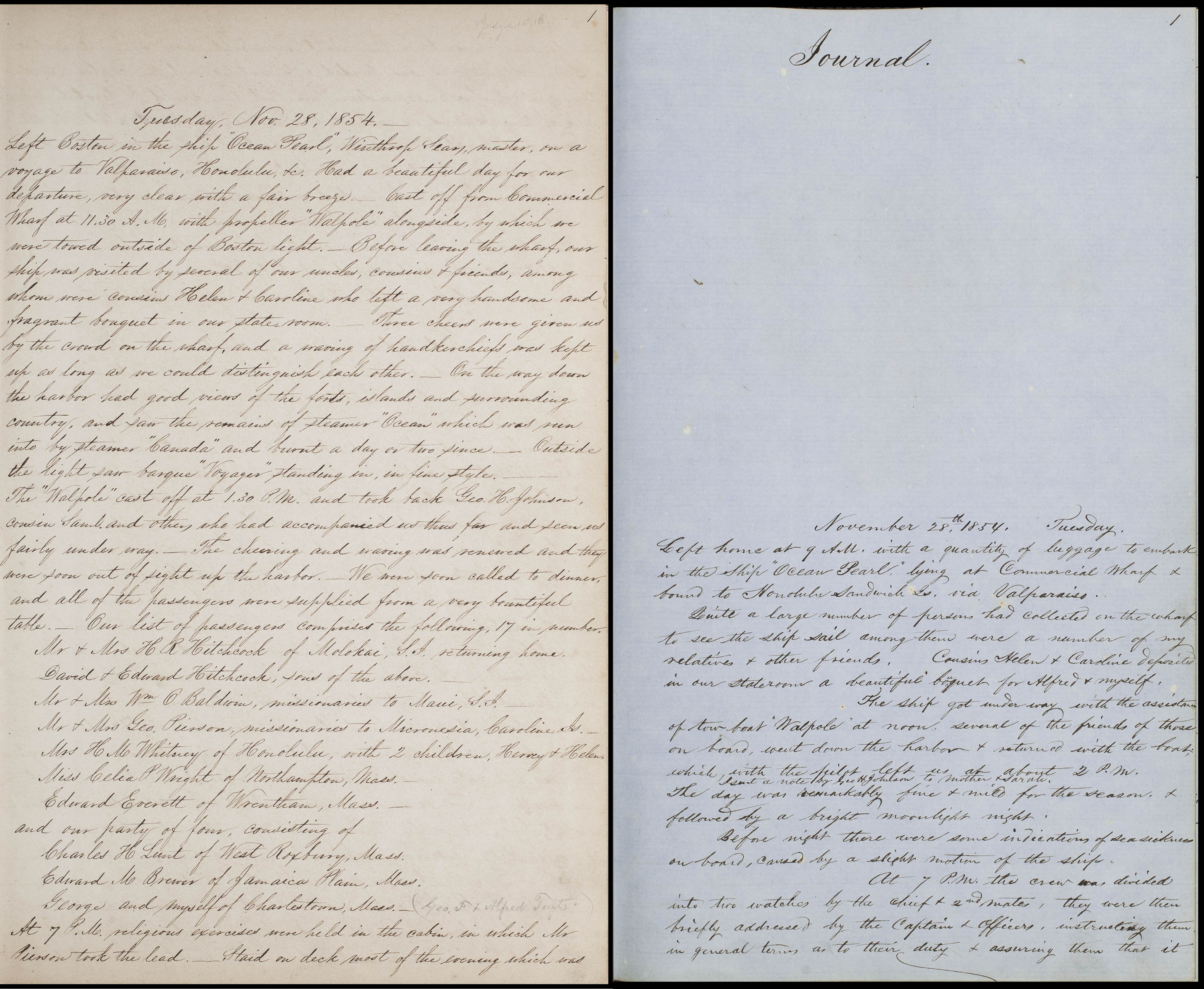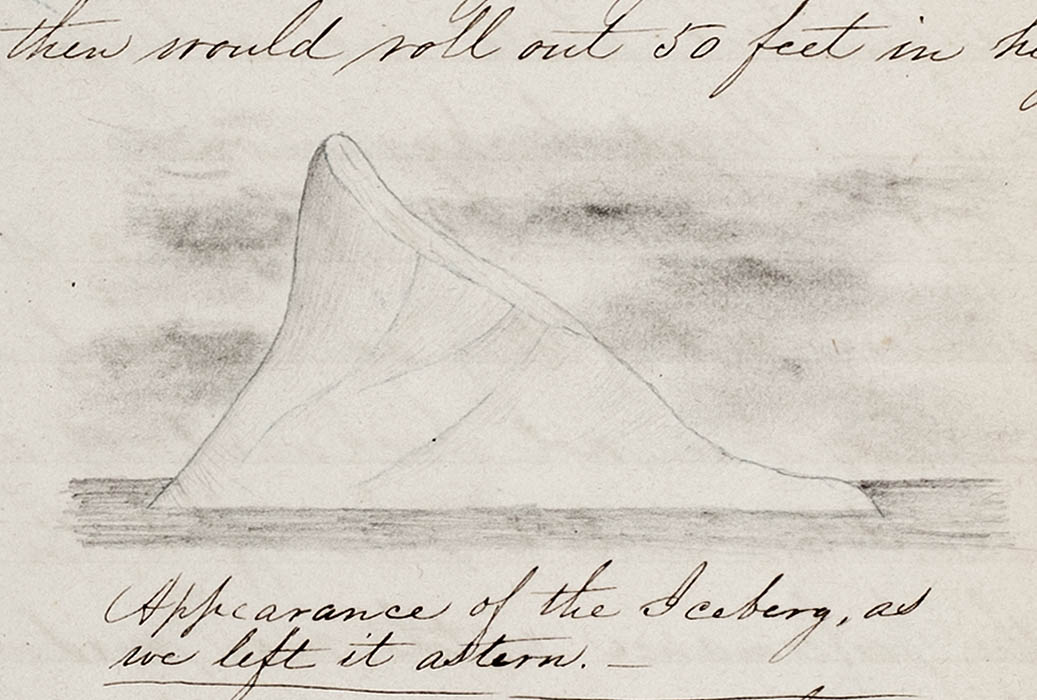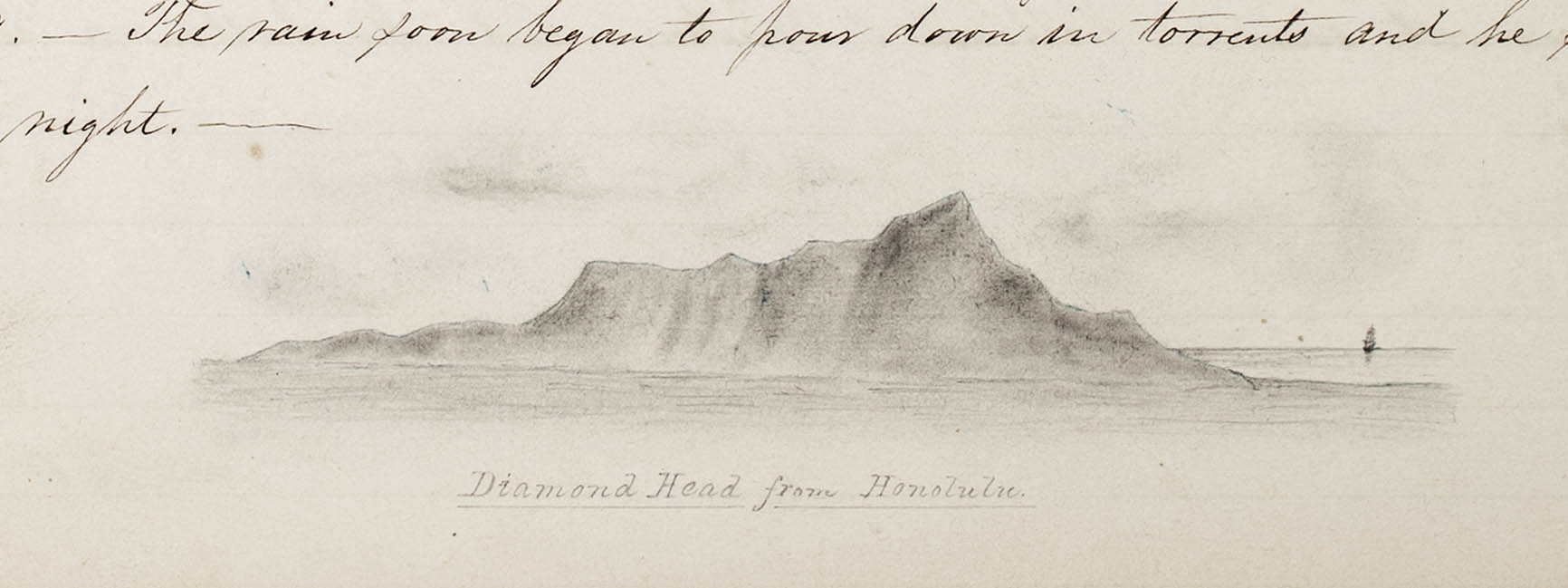By Anna Clutterbuck-Cook, Reader Services
A new year means a new serialized diary here at The Beehive, where for the past four years we have showcased a diary from the collections written one hundred years ago (you can read the 2015, 2016, 2017, and 2018 series in our archives!).
In October 1913 a fifty-nine year old man, George Hyland of Hingham, Mass., was given a hardbound standard diary by his representative to the Massachusetts state legislature, Rep. Charles H. Waterman. Rather than using the book as intended–filling one page per day for the year–Hyland instead began recording his life story in dense, script beginning with his childhood memories of the Civil War. Once he reached the present, Hyland continued to fill the diary until 1922, including the daily details of his life during the year 1919.

The year of 1919 opened “Cloudy. Cold. W.N.W. tem. about 25-36.” As you will see, the weather is a continual refrain in George’s diary — as you might expect for someone who spends his days outside chopping and hauling wood, walking to buy groceries, and visiting family. In order to make the most economical use of space in his diary, George abbreviates common words: “Staid [sic] all aft. ret. to N. S. on tr.” Stayed all afternoon, returned to North Scituate on train. We read about the price of milk (“now 12 cts per quart”) and the mundane tasks of life (“Mended some of my clothes in the eve.”) as well as entertainments (“Music by victrola in the sitting room.”) and tragedies: “A great mollasses [sic] tank exploded about 1 P.M. to-day on Commercial St., Boston.” We also get glimpses of the way in which the Great War continues to cast its long shadow even after the armistice. “Little Elizabeth,” George writes on January 21st, “came into the Swamp to tell me to come to the house and eat dinner. She is only 4 years old. She said her papa went to the war to fight the Germans and now he is dead.”
Join me in following George Hyland during one year of his life in the early 20th century.
* * *
PAGE 320
1919
Jan 1. Cloudy. Cold. W.N.W. Tem. about 25-36. Misty rain at times, very heavy fog all day. Eve warm, tem. 55 W.S.W. mod. Gale and rain — max. wind about 34 m.
2d. Mod. rain all day and eve. W.N.W. tem. About 36. Called at uncle Samuel’s late in aft. Lt. Weyland and Nellie G. Sharpe there, Elizabeth Bahe there, is to stay with Ellen at present.
3d. Rain all day and eve. W.N.W. to N.E. tem. About 27-32. Late in aft. Went to Lt. Weyland’s and bought a bus. of potatoes. Also bought some bread at H. Litchfield’s, then went to Mrs. Merritt’s and bought some milk. 10 P.M. snowstorm. W.N.E. Sawed some cedar logs in the cellar (some […] outlast winter) and put the wood in the back chamber — also put some planks and timbers there. Snowstorm all night
4th. Forenoon cloudy, aft. Clear. Tem. about 28-25, W.N.W. early in eve. Went to N. Scituate. Walked down and back. Stopped at Mrs. Merritt’s and bought some milk. Eve. clear. Cold. 3 inches of snow on the ground.
5th (Sun.) Clear. Cold. W.N.W. tem. 12-26 early in eve. Bought some milk at Mrs. Merritt’s. Staid [sic] there 1/2 hour. Music by victrola in the sitting room. Elizabeth sent me a cornball this aft. Eve. clear. cold; tem. 12. Got 2 sledloads of wood in Swamp this aft. Called at Uncle Samuel’s in eve.
6th. Light snowstorm early A.M. W.N.E. forenoon clou. aft. Par. clou. to clear. Tem, 26. Eve clear. W.N.W. tem. 7 P.M. 12. Got 2 sledloads of wood in Swamp. This aft. Called at Uncle Samuel’s early in eve.
7th. Light snowstorm early A.M. clear after 10 A.M. tem. About 18-38, W.N.W. in forenoon, S.E. in aft. N.W. in eve. Eve clear. Mended some of my clothes in eve. Called at Uncle Samuel’s later in aft. Elizabeth gave me a cornball.
8th. Clou. A.M. began to rain at 11 A.M. tem. 24-38. Bought some milk at Mrs. Merritt’s in eve. Clear in eve. W.W.N.W.
9th. Cloudy. Chilly. Damp. late in the forenoon walked to N. Scituate. Went to Hingham 12:17 tr. Went to Henrietta’s. Had dinner there. Carried a lot of toy furniture for her to sell for Henry. Staid [sic] all aft. ret. to N. S. on tr. at about 5:15 P.M. Walked home in eve. Brought my […] bag ([…]) full of clothes — coats, pants, etc. heavy to carry. Tem. to-day about 23-36. W. W. S. W. late eve. par cloudy. colder. very windy.
10th. Par. clou. to clear. W.N.W. and S.W. tem. 9-24. Called at Uncle Samuel’s in aft. Gave Elizabeth an orange and a bannana [sic] (Henrietta gave them to me yesterday). Got some wood in Swamp late in aft. Went to H. Litchfield’s and bought some bread early in eve. eve. clear. Cold.
11th. Split wood (very large pieces) 3 hours for Jane Litchfield. 75. Had dinner there. Early in eve. went back to N. Scituate. Walked down and back. Bought some groceries at Mr. Seavern’s store. Mrs. S. got […] for me also some chocolate candy (2 cts) for Elizabeth. Tem. 30-18. W.N.W. fair to par. clou. eve. cold. Tem. 9.
12th (Sun.) Clear. W.N.W. tem. 2-24. Eve. cold. clear. calm.
13th. Fine weather; clear; W.S.W. tem. 8-34. Fine eve. Got some dead wood in Swamp 1/2 mile from here to-day. Hard to get along there is so much dead wood piled up lying in all directions.
14th. Got some of my wood out of the Swamp (wet in Swamp to-day). Also cut wood 2 1/4 hours in Swamp for Uncle Samuel. He was cutting wood there. Cloud. Wind. S. to S.W. tem. 34-44. Early in eve went to N. Scituate. Bought some groceries at Mrs. Seavern’s store. Also bought some cold tablets for Ellen and some quinine (for toothache) for myself (1 doz 2 gr. Sulph Quinia pills – 15 cts). Bought some milk at Mrs. Merritt’s — milk is now 12 cts per quart. Margaret Brown medicine for me at the Drug Store. Eve. clou.
15th. Cut wood 4 hours for Uncle Samuel. Cloudy A.M. 11 A.M. clear. W.N.W. tem. 32-42. Had supper at Uncle Samuel’s. Eve. clou. Fine weather
A great mollasses [sic] tank exploded about 1 P.M. to-day on Commercial St., Boston. 2,250,000 gallons ex. des. buildings, flooded street, k. 11 men, women, and children, and injured 60 others. Several horses k. 1 girl
PAGE 321
[cont’d] a. about 12 was drowned in the molasses.
16th. Cut wood 5 hours. Very fine weather. Clear. tem. 32-46 W.W.S.W. bought some milk at Mrs. Merritt’s early in eve. Fine eve. tem. 35. Weather is like early spring.
17th. Cut wood 6 hours. clou. A.M. Clear at 11 A.M. aft. par clou. to clou. a few drops of rain. 3 P.M. clear. eve. clear. temp. to-day – 30-48. W.S. to S.W.
18th. Cut wood 5 hours in Swamp. Cloud A.M. W.N.W. began to rain about 11 A.M. rain light for 1 1/2 hours. aft light misty rain, W.N.E. tem. To-day 30-36 early in eve. Walked to N. Scituate. rode back with Albert Litchfield. Stopped at Mrs. Merritt’s and bought some milk. Eve very foggy. L. E. Bates here while walking to N. Scituate. I boxed the compass four times each way – backwards and forwards – N. by way of E. back to N. – then by way of W. back to N. – then S. to E. both ways, then S. to S. both ways – then W. to W. both ways. I like to do it.
Bought 5 cents worth candy for Elizabeth.
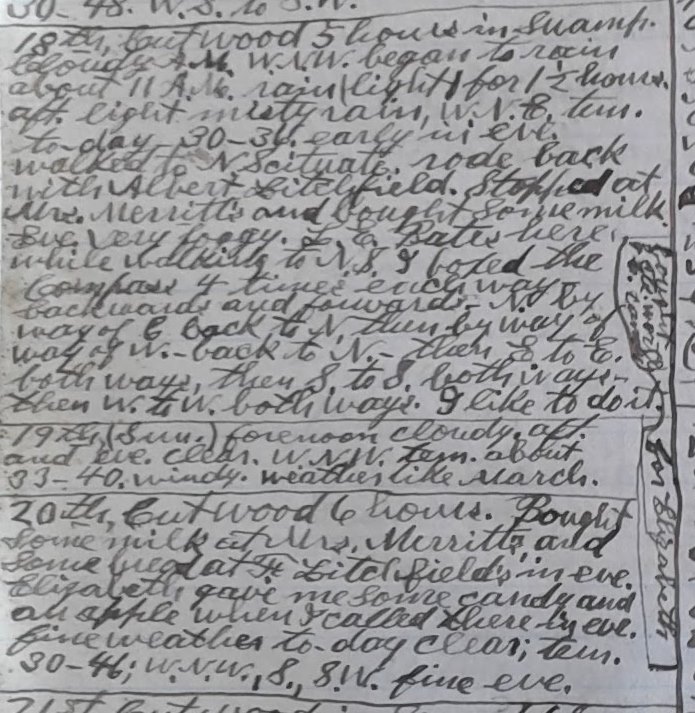
19th. (Sun.) forenoon cloudy. aft. and eve. Clear. W.N.W. tem. About 33-40. Windy. Weather like March.
20th. Cut wood 6 hours. Bought some milk at Mrs. Merritt’s and some bread at H. Litchfield’s in eve. Elizabeth gave me some soure [sic] candy and an apple when I called there in eve. Fine weather to-day clear; tem. 30-46; W.N.W., S., S.W. fine eve.
21st. Cut wood in Swamp 6 hours. Had dinner at Uncle Samuel’s — little Elizabeth came into the Swamp to tell me to come to the house and eat dinner. She is only 4 years old. She said her papa went to the war to fight the Germans and how he is dead. (Was in the U.S. Navy). Elizabeth is Sarah’s third daughter. Cloudy. very damp to-day, W.N.E. and S.E. tem. 36-44. Very wet in the swamp. Eve. clou. W.S.E. will prob. Rain or snow to-night or to-morrow.
Last eve. (5-9 P.M.) I heard a great number of steamer whistles in Boston Harbor. [word] were saluting the Stm. “Canada” just arrived from France, with a load of soldiers. The whistling continued for 15 min.
22nd.Cut wood in the Swamp 6 hours. Finished cutting 2 1/2 cords of hardwood for Uncle Samuel. 625. Cloudy. Very damp. W.S. to S.W. tem. 34-46. Bought some choc. Candy for Elizabeth – 3cts. She came into the Swamp today. Eve. cloudy. 10:30 P.M., misty rain, W.W.
23rd. Cloudy. Foggy. W.S. tem 40-44. Got some wood in Swamp. In aft. Put rivet in a pair of scissors — also sharpened them — for Mrs. Merritt. 15. Late in aft. Went to N. Scituate. Bought some groceries at Mrs. Seavern’s Store. Also some choc. Candy for Elizabeth – 3cts. Walked down and back. Eve. clou. 9:30 P.M. began to rain. Rain all night.
24th. Cloudy to par. Cloudy. Very windy. tem. About 34-37 W. N.W. did some work at home. Early in eve. Went to H. Brown’s store. Wind blowing a gale – (40m.) Cold. Clear. Windy all eve. mod. At 11:50 P.M. much colder.
25th. Did some work at home. Very fine weather for […]. Clear; W.N.W; tem. 26-37. Paul Briggs […] home to-day – stopped here nearly 2 hours – had dinner here with me. He has been in the U.S. Army for one year and 4 months – has not had a furlough for a year – been on duty all the time — was in […]U.S. […] Guards — on duty at Jersey City, N.H. — pier 1 where the U.S. transports leave for […]. They had to guard the stores, supplies, and etc. He was discharged yesterday, and came from a Mil. Sta. in Pa. come on the 11:15 P.M. tr. from N.Y. last night had honorable discharge. The soldiers are coming home now as fast as they can get them here. Went to N. Scituate early in the eve. Bought some milk at Mrs. Merritt’s. Fine eve.
PAGE 322
[cont’d] Jan. 25. Paul brought home a box of fine cigars, which the capt. of his gave him. Paul gave me one of them (15 ct cigars). Paul was in the 16th Div. U.S. Army — Co. L. 302nd Inf. — but was transferred to Co. A. U.S. Guards.
Gave 25cts for [word] to soldier.
26th (Sun.) Clear; tem. about 26-40. W.N.W. eve. clear.
27th. Cut wood in Swamp 5 hours for Lt. Weyland. Fine weather. W. N.W., tem. about 28-40. Early in eve. Bought some milk at Mrs. Merritt’s. Eve. par. clou.
28th. Sold E. Jane Litchfield 1 1/2 ft. of cedar wood for kindling. 150. Split it into very small pieces, also split some large pieces of hardwood, and housed the whole. 5 hours in all. 125. Had dinner there. Fine weather, fair to par. clou. tem. 32-40; W.N.W., N.E, S.E., S.W. early in the eve. Went to N. Scituate – bought some groceries at Mrs. Seavern’s Store – also some choc. candy for Elizabeth – 3cts. Rode 1 1/4 miles with George Hardwick in auto. Alma Lincoln and Irene Dalby brought a […] of Mt. Blue Spring water to E. Jane Litchfield late this aft. eve. clear but hazy at times. Stars look very small — will snow or rain soon.
29th. Light snow storm all day. W.N.E.; tem. 37. Cut wood in Swamp 1 hour in aft. Early in eve. Went to H. Brown’s store — also went to Mrs. Merritt’s and bought some milk. Eve. clou. 10 P.M. clear; W.N.W.
30th. Cut wood in Swamp 5 hours. fine weather, clear; tem. about 30-40; W.S.W. Snow nearly all melted today. Bought some milk at Mrs. Merritt’s in eve. Fine eve. clear. warm for season. W.S.W., by W.
31st. Cut wood 5 1/2 hours in Swamp. Clear, windy. (M.W.) tem. 28-40. Cold late in aft. and in eve, windy early in eve. Bought some milk at Mrs. Merritt’s, also got some for Ellen, then went to H. Litchfield’s and bought some bread. Cold night.
* * *
If you are interested in viewing the diary in person in our library or have other questions about the collection, please visit the library or contact a member of the library staff for further assistance.
*Please note that the diary transcription is a rough-and-ready version, not an authoritative transcript. Researchers wishing to use the diary in the course of their own work should verify the version found here with the manuscript original. The catalog record for the George Hyland’s diary may be found here. Hyland’s diary came to us as part of a collection of records related to Hingham, Massachusetts, the catalog record for this larger collection may be found here.


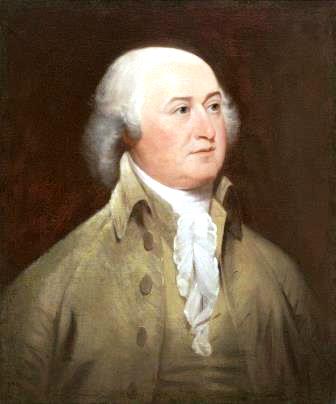
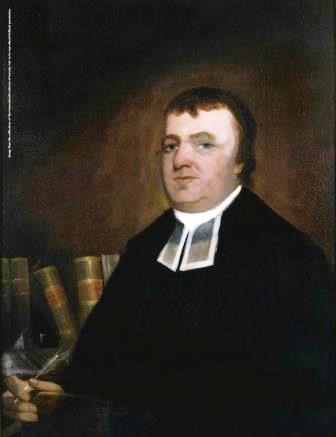
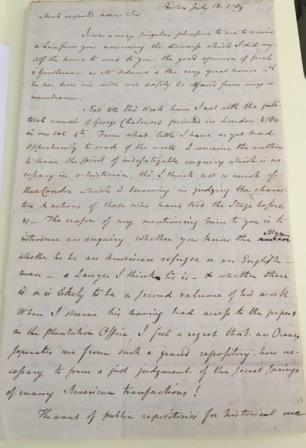
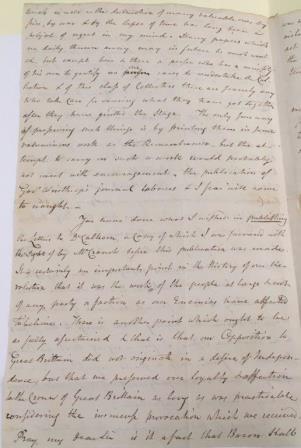
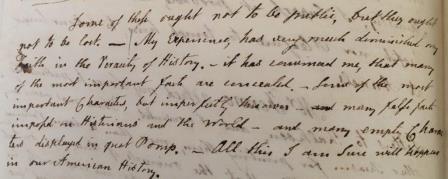


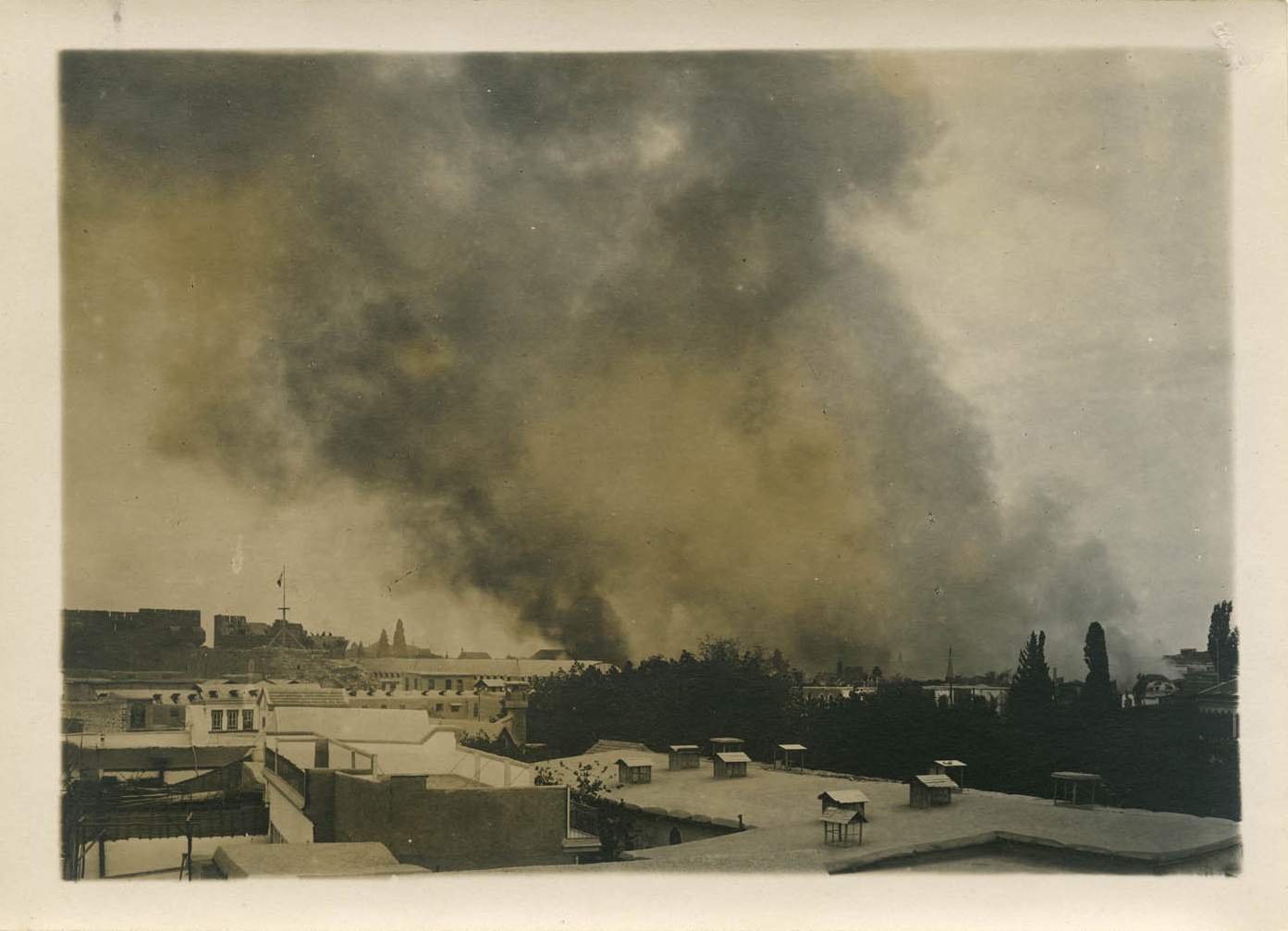


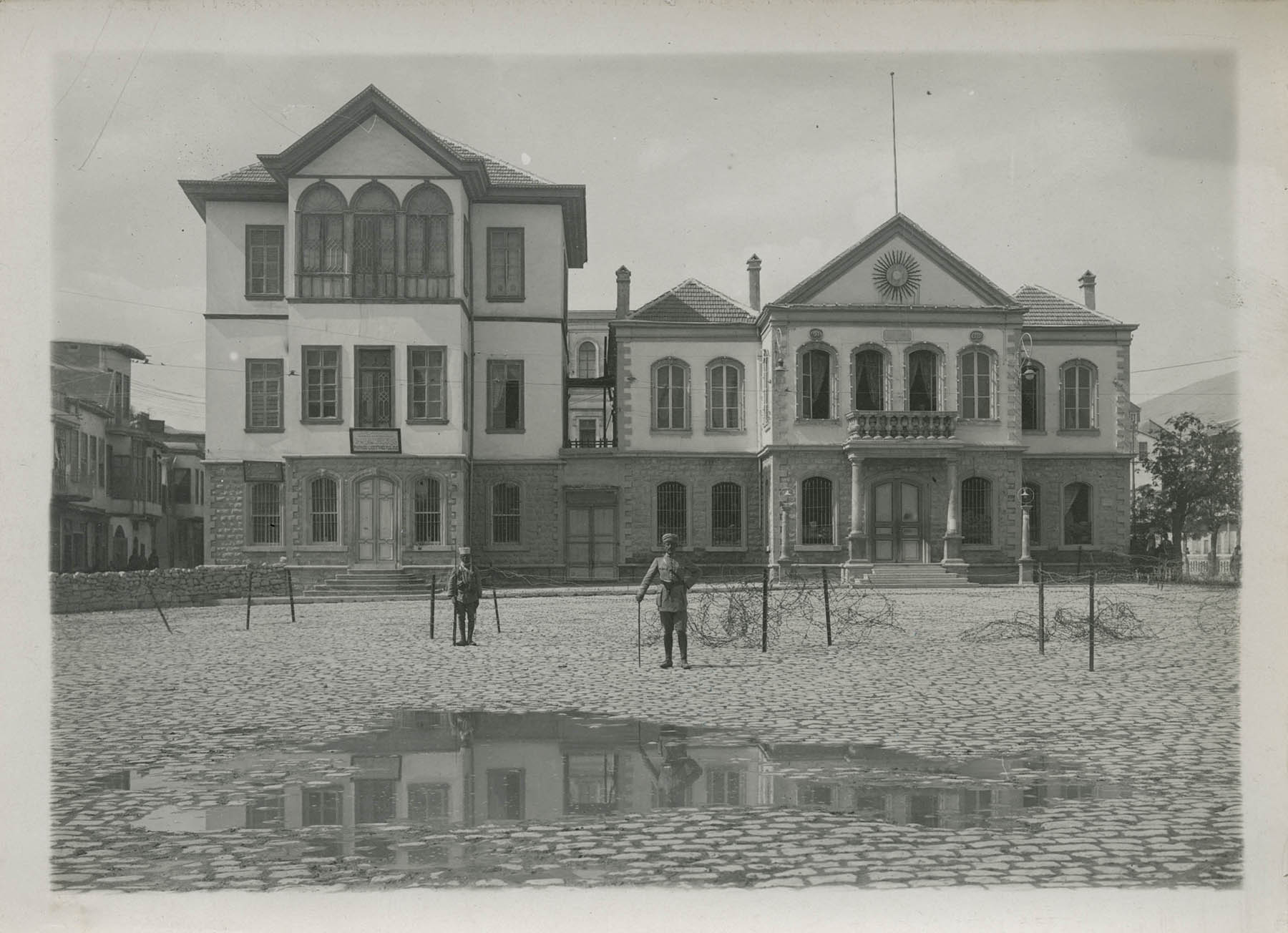

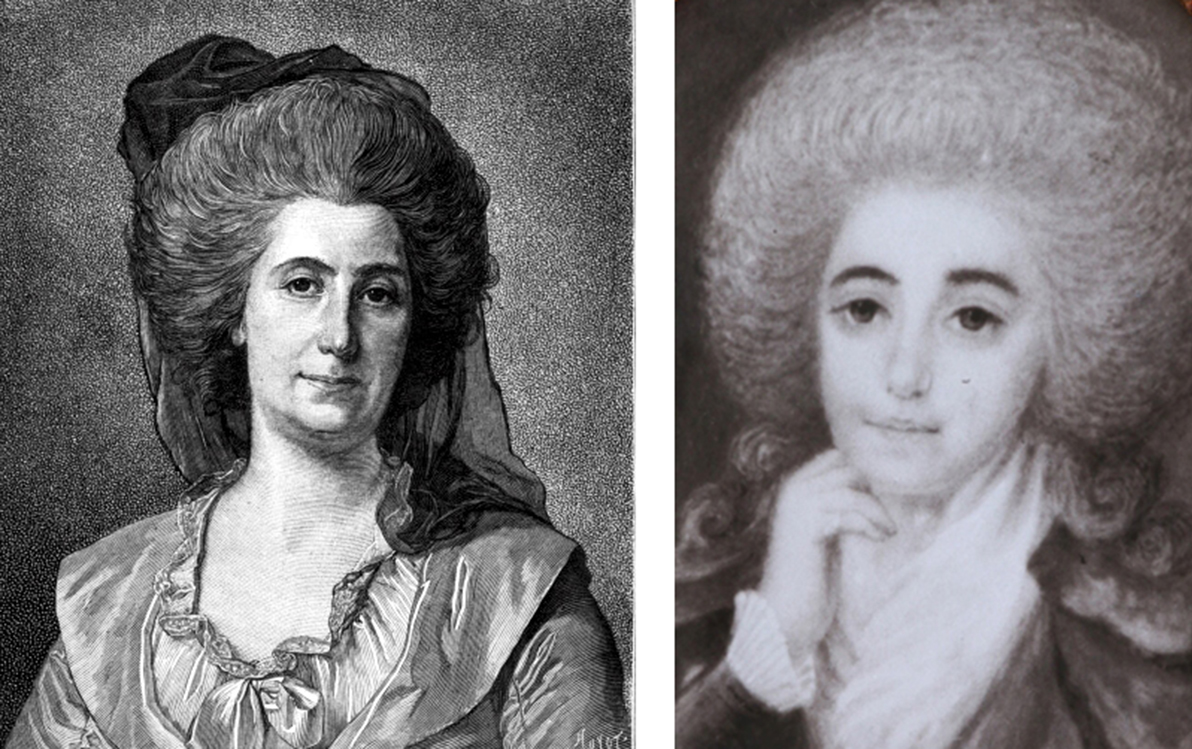 Left:
Left: 


